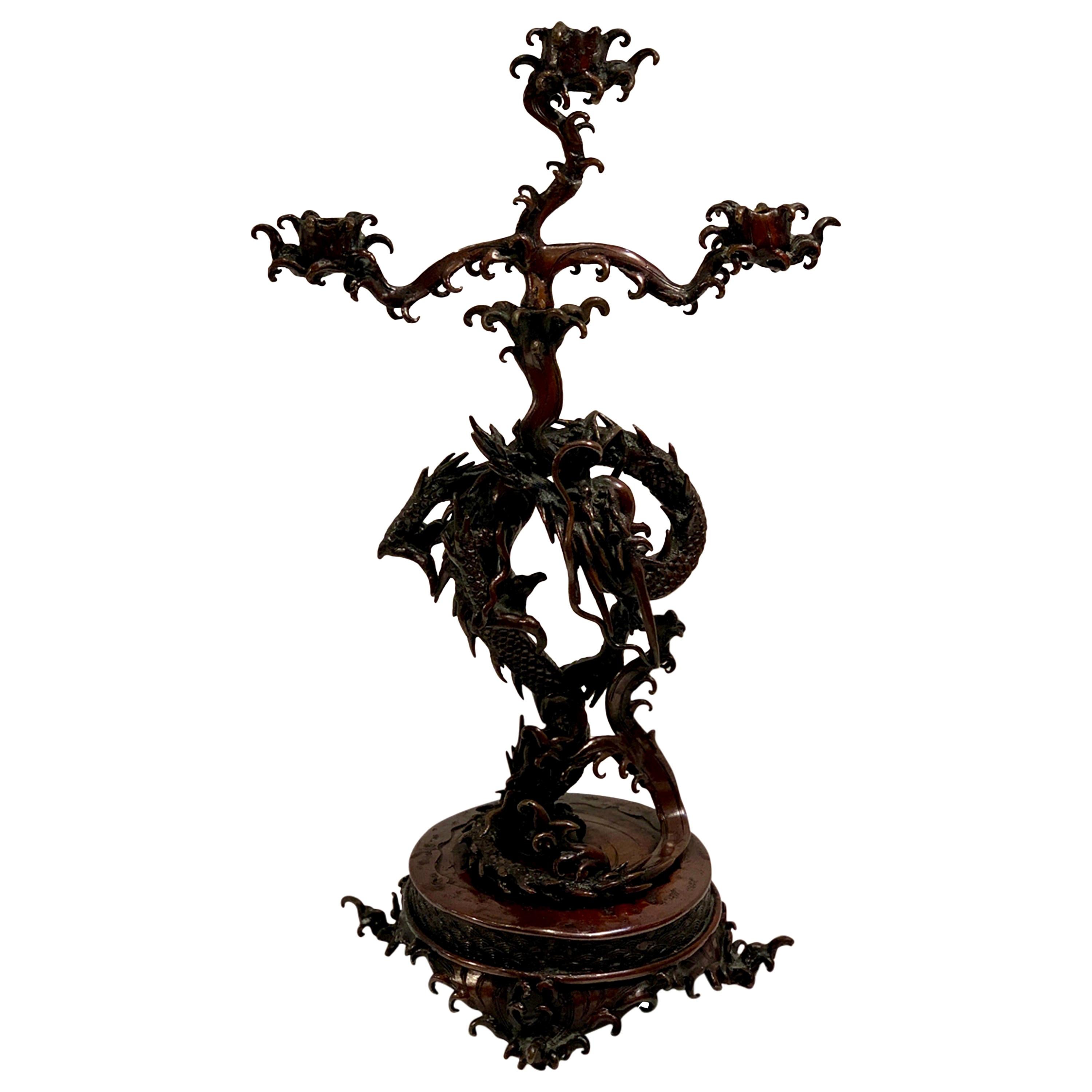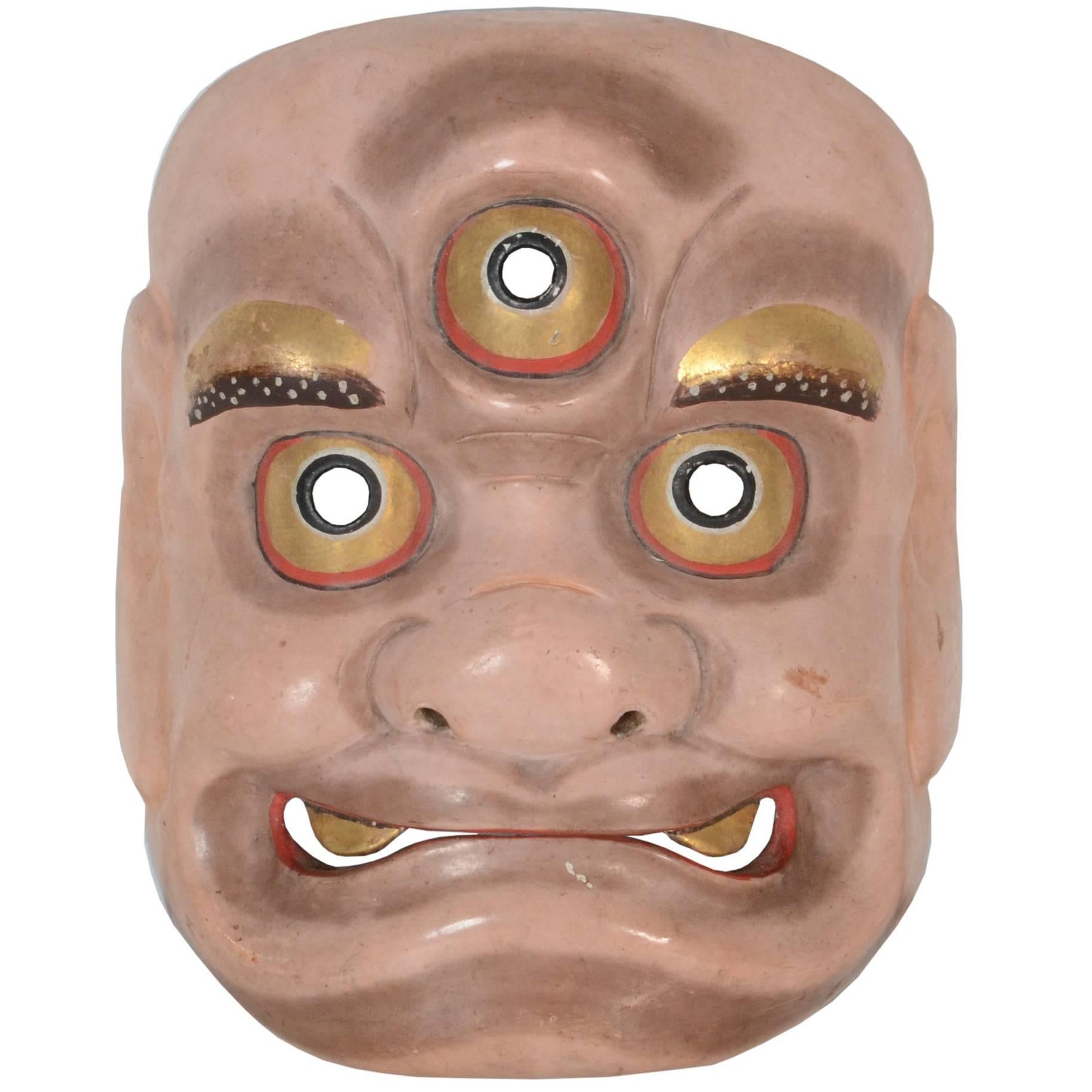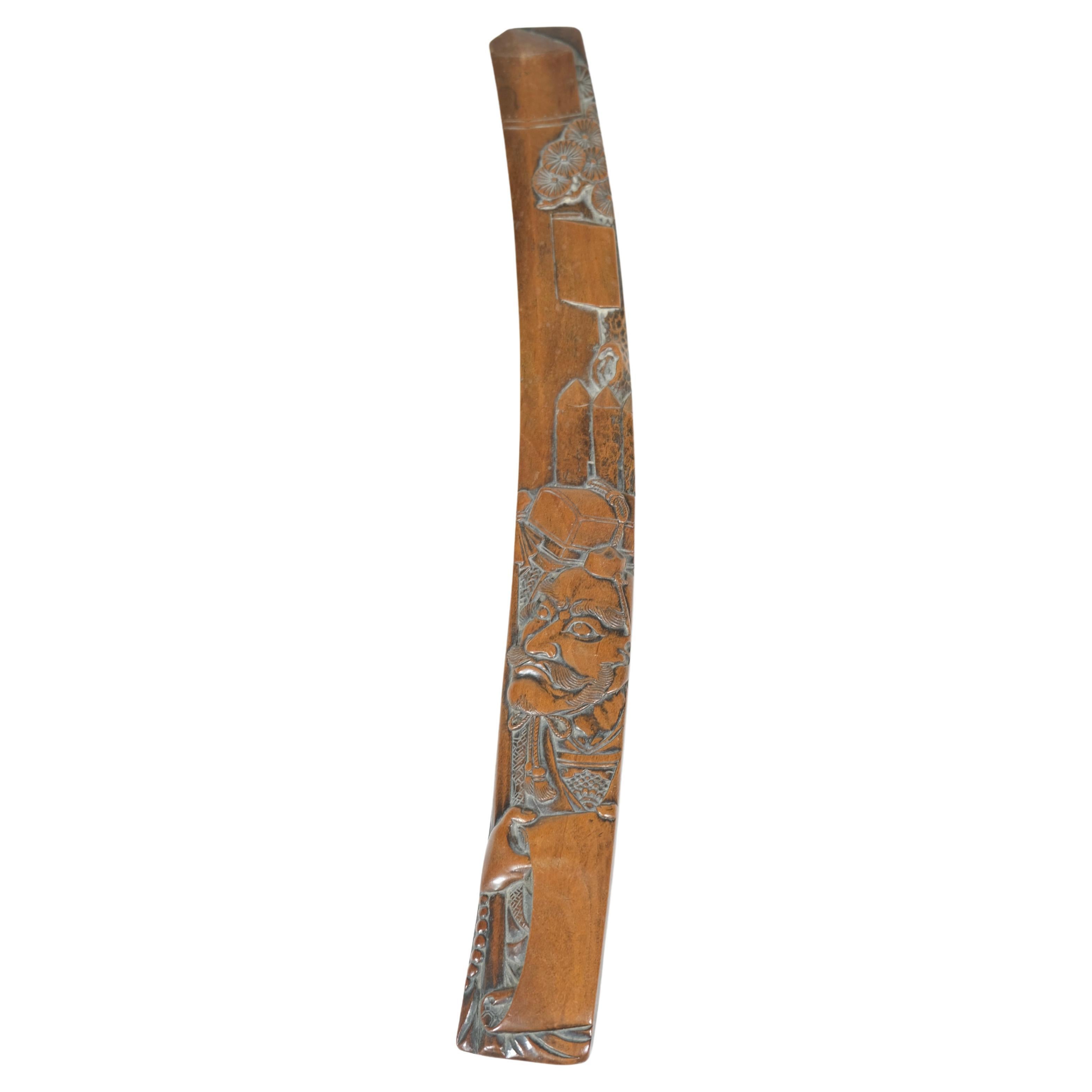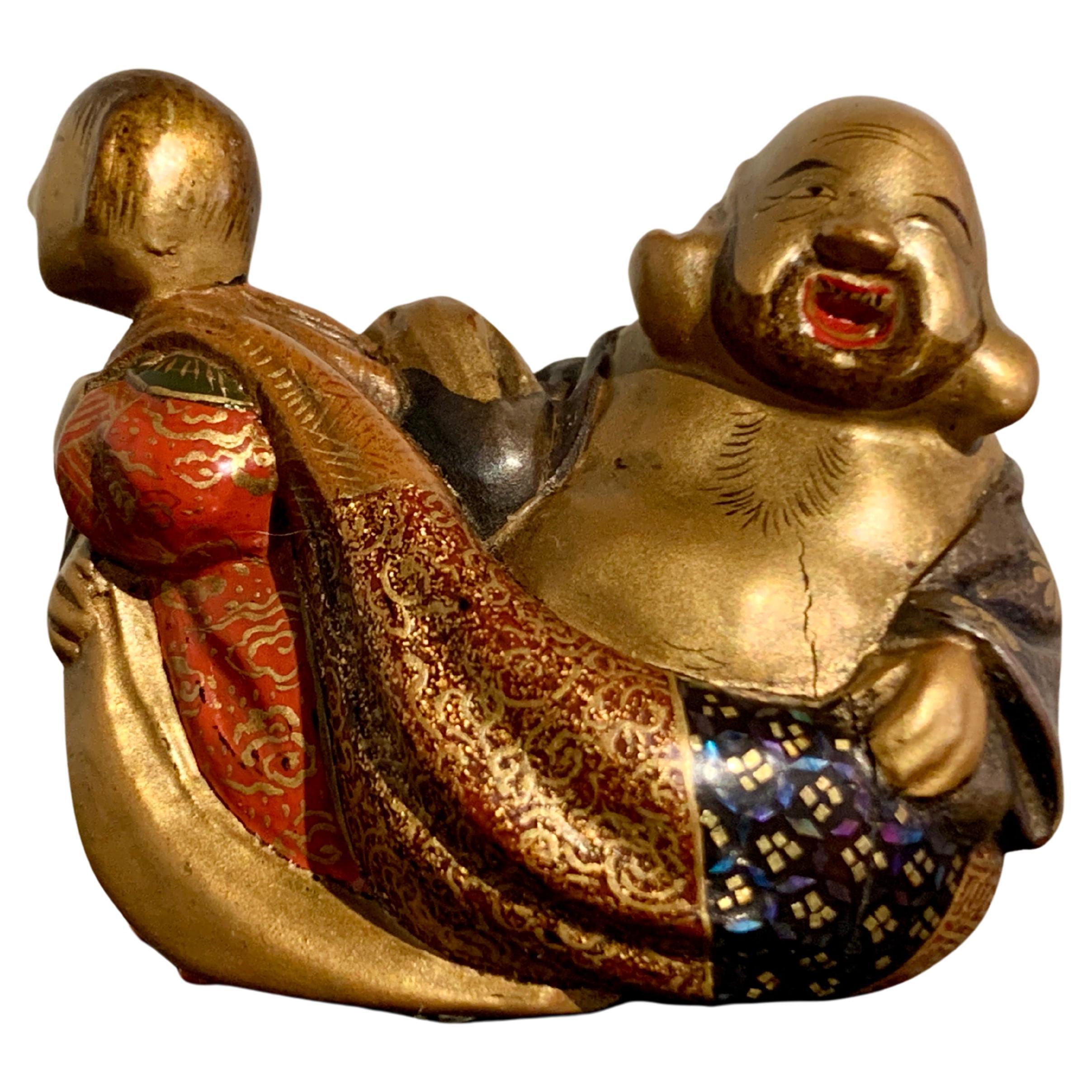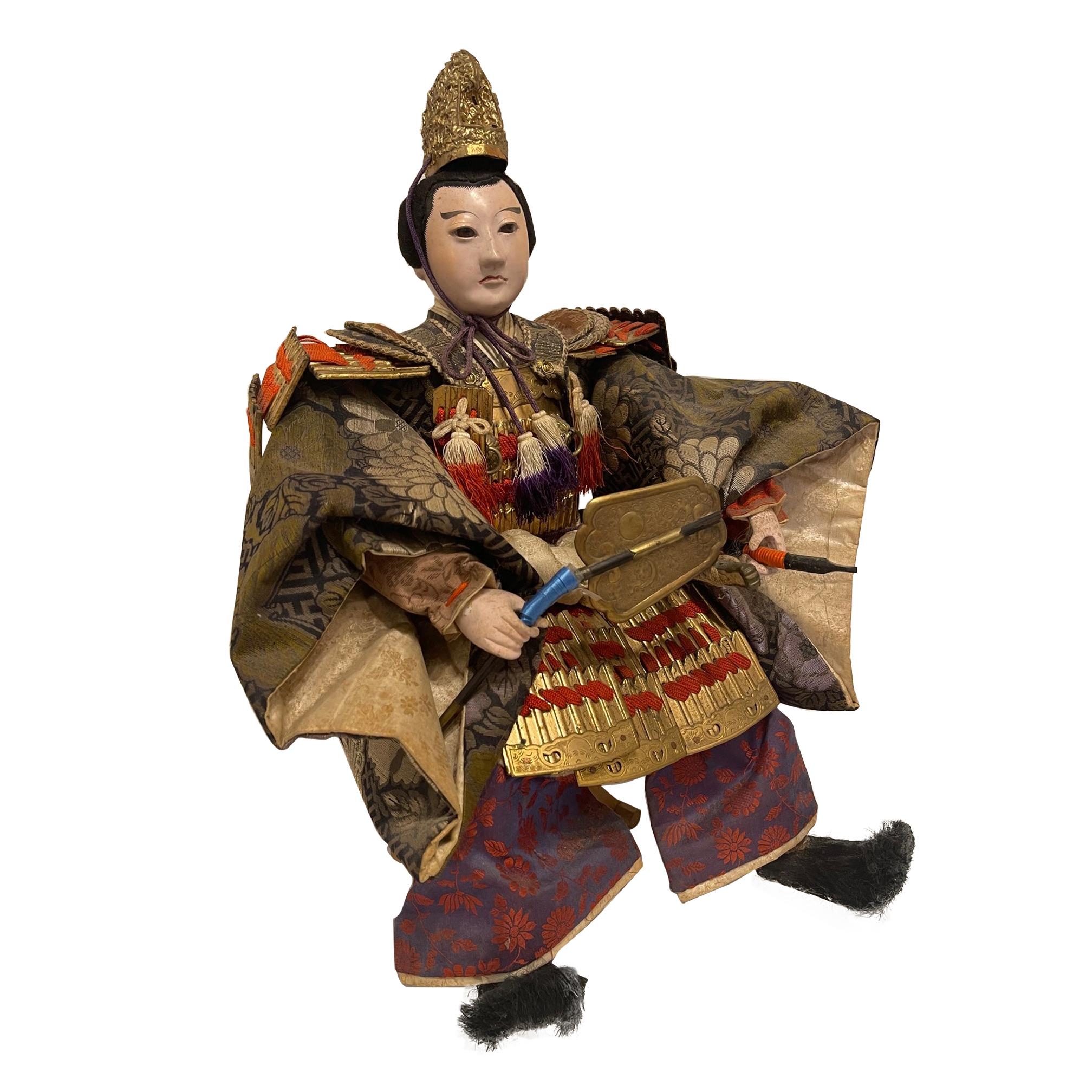Items Similar to Japanese Erotic Otofuku Folk Art Carving, Late Meiji Period, circa 1900
Want more images or videos?
Request additional images or videos from the seller
1 of 10
Japanese Erotic Otofuku Folk Art Carving, Late Meiji Period, circa 1900
About the Item
Rare and highly unusual Japanese Folk Art wood carving depicting the folk heroine and good luck figure Otafuku with a finely painted erotic design on the interior and a carved inscription on the reverse, late Meiji period, circa 1900.
The inscription is written in Chinese script, allowing it to be read either as a classical Chinese poem or, if translated into Japanese, as a vivid description of lovemaking, referencing the erotic images painted behind the central figure.
Dimensions: H 65cm x W 38.5cm x D 4cm
Overall the piece is in good condition but does have a number of areas of darkening to pigments and some flaking on the interior paintings as shown in images.
Please contact us for additional images.
- Dimensions:Height: 25.6 in (65 cm)Width: 15.16 in (38.5 cm)Depth: 1.58 in (4 cm)
- Style:Meiji (Of the Period)
- Materials and Techniques:
- Place of Origin:
- Period:
- Date of Manufacture:circa 1900
- Condition:Wear consistent with age and use. Minor losses. Minor fading.
- Seller Location:Prahran, AU
- Reference Number:
About the Seller
5.0
Vetted Seller
These experienced sellers undergo a comprehensive evaluation by our team of in-house experts.
Established in 1979
1stDibs seller since 2015
76 sales on 1stDibs
Typical response time: 1 to 2 days
- ShippingRetrieving quote...Ships From: Prahran, Australia
- Return PolicyThis item cannot be returned.
More From This SellerView All
- Japanese Theatre Mitsumekozo Theatre Mask Meiji Period, circa 1900Located in Prahran, VictoriaUnusual Japanese Folk Art theatre mask depicting the playful character Mitsumekozo, a three eyed goblin often portrayed as a mischevious creature in comical plays, late Meiji period,...Category
Antique Late 19th Century Japanese Meiji Sculptures and Carvings
MaterialsWood
- Antique Japanese Gilded Statue of a Shinto God, Momoyama PeriodLocated in Prahran, VictoriaA Japanese statue of a Shinto god from the Momoyama period. Hand carved from wood with a layer of gesso and hand painted flowing robes with delicately wroug...Category
Antique 16th Century Japanese Sculptures and Carvings
MaterialsGesso, Wood
- Antique Japanese Statue of Dakini TenLocated in Prahran, VictoriaRare and highly unusual antique Japanese statue of the esoteric deity 'Dakini Ten,' a Buddhist goddess who was associated with the agricultural...Category
Antique 1770s Japanese Sculptures and Carvings
MaterialsGesso, Wood
- Rare Buddhist Carved Base for a Statue, Edo Period, 17th CenturyLocated in Prahran, VictoriaRare and unusual hexagonal Buddhist base for a statue with a recumbent shi-shi (guardian lion dog), gilded and carved with inset glass eyes and painted with mineral pigments. Most likely the base to a sculpture of Monju Bosatsu...Category
Antique Mid-17th Century Japanese Edo Animal Sculptures
MaterialsWood
- Japanese Black Lacquer Document Box with Gold Maki e Design, Meiji PeriodLocated in Prahran, VictoriaAn antique black lacquer document box with an exquisitely detailed, finely wrought design from The Tale of the Genji depicted in gold maki e across the lid. Internally, the box is de...Category
Early 20th Century Japanese Lacquer
MaterialsWood, Lacquer
- Japanese Bijin-ga Painting of Woman in Period Kimono, Taisho Period, circa 1920Located in Prahran, VictoriaRare Japanese Taisho period Bijin-ga style painting of a beautiful woman in period kimono holding a fan, circa 1920. Bijin-ga is a Japanese term used to describe paintings or pict...Category
Vintage 1920s Japanese Taisho Paintings and Screens
MaterialsSilk
You May Also Like
- Meiji Era circa 1900 Antique Japanese Bronze Sea Dragon 3-Arm CandelabraLocated in Tustin, CAMagnificent and powerful, fantastically sculptural, ferocious bronze Japanese writhing sea dragon candleholder is coiled around itself, with an uplifted head and a stylized plume of ...Category
Antique Late 19th Century Japanese Meiji Antiquities
MaterialsBronze
- Japanese Red Samurai Armour Beginning of Meiji period 1900sLocated in Paris, FRThis is an armour of samurai. It was made around 1900s in Meiji era. This armour was not used in actual war so it was made as decoration, because of that, it is in good condition as ...Category
Antique Early 1900s Japanese Meiji Antiquities
MaterialsMetal, Iron
- Boxwood and Lacquer Netsuke of Hotei by Shunsho, Meiji period, circa 1900, JapanLocated in Austin, TXA charming and finely decorated carved and lacquered boxwood netsuke of Hotei by Shunsho (probably Shunsho XI, Masaoki), Meiji period, circa 1900, Japan. This delightful and colorful netsuke features the beloved figure Hotei, one of the Seven Lucky Gods. The god of fortune and happiness is seated upon his treasure bag, and being dragged by a smiling child. Carved from boxwood and decorated in bright lacquers of gold, silver, red, black and green. Hotei's chest and ample stomach mostly exposed, his skin covered in gold lacquer. Large elephantine ears frame his bearded face. His red-lipped mouth open in an uproarious laugh. Hotei's treasure bag formed as a patchwork of various brocades in gold, red, and black lacquer. The black lacquer further decorated in the lac burgaute...Category
Antique Early 1900s Japanese Meiji Sculptures and Carvings
MaterialsBoxwood, Lacquer
- Japanese Wooden Dagger, Late 19th CLocated in Stockholm, SEA Japanese high quality wooden dagger. The carving is made of the highest quality as often Japanese items are. There is a signature and a poem engraved on side. Comes from an old Swedish collection...Category
Antique Late 19th Century Japanese Edo Sculptures and Carvings
MaterialsBoxwood
- Japan 1890 Meiji Period Ebisu Sculpture in Wood Carving of an Old FishermanLocated in Miami, FLAn extremely well detailed wood carving of Ebisu, as a fisherman. Beautiful and well detailed sculpture, created in Japan during the Meiji dynastic period (1868-1912) back in the 1890's. This piece represent the god of good fortune Ebisu. Was exceptionally carved and executed from one solid single piece of rose wood, showing a gorgeous face expression, with intricate details in the hands and feets, he's carrying as usual a rod and a fish. Ebisu (yebisu), ???, god of fortune, the ocean and fisherman. In the japanese mythology is one of the seven gods of luck, sichi-fuku-jin, the patron of the fisherman and tradesmen. he is depicted as a bearded, smiling fisherman with formal long court ropes, often carrying a rod in one hand and a tai, symbolic fish of the good luck, in the other. The height is 14.25 inches (36.20 cm) and the base measurements is 6.5 by 6.45 inches (16.5 x 16.38 cm). Meiji period, is an era of Japanese history that extended from October 23, 1868 to July 30, 1912.The Meiji era was the first half of the Empire of Japan, when the Japanese people moved from being an isolated feudal society at risk of colonization by Western powers to the new paradigm of a modern, industrialized nation state and emergent great power, influenced by Western scientific, technological, philosophical, political, legal, and aesthetic ideas. As a result of such wholesale adoption of radically different ideas, the changes to Japan were profound, and affected its social structure, internal politics, economy, military, and foreign...Category
Antique 1890s Japanese Meiji Sculptures and Carvings
MaterialsWood
- Japanese Samurai Doll or Figure, Meiji Period, Circa 1830Located in Savannah, GAJapanese Samurai Doll or Figure, Meiji Period, circa 1830. Skirt purple and red colors.Category
Antique Early 19th Century Japanese Meiji Antiquities
MaterialsPorcelain
Recently Viewed
View AllMore Ways To Browse
Antique Folk Art Carvings
Antique Folk Art Carving
Wood Carving Figural
Erotic Furniture
Erotic Sculpture
Reverse Carved Painted
Antique Cypress
Asian Painted Wood Carving
Classical Japanese Furniture
Antique Cypress Furniture
Good Luck Asian
Japanese Meiji Carving
Japanese Luck
Chinese Carving Figure
Meiji China
Antique Erotic Furniture
Folk Art Carved Unusual
Carved Japanese Figure
